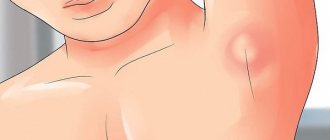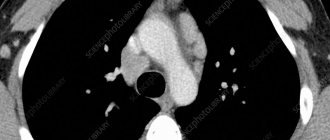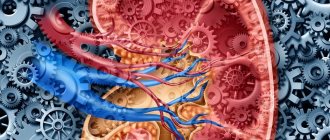Every third appeal to an oncologist on social networks or on remote consultation portals is formulated something like this: “save, help, I have enlarged lymph nodes.”
As a rule, young people write, usually from 18 to 25 years old, and I don’t remember a case when it eventually turned out that the situation required treatment from an oncologist. Most often, enlarged lymph nodes were caused by a sore tooth, sore throat, conjunctivitis, and so on.
It is clear that fear and fears for one’s health in such cases force one to immediately run to an oncologist.
However, is everything so simple, and is it worth rolling your eyes about any treatment with an enlarged lymph node?
My personal statistics show: if a person comes for a face-to-face consultation, he is already one of those few whose situation was not limited to the banal “it got sick and went away.”
Let's take a closer look at how the lymphatic system works and understand the nature of enlarged lymph nodes.
Fact #2
Lymphatic vessels are not something abstract.
It is worth crossing or ligating them, for example, during surgery on the axillary lymph nodes for breast cancer, and lymphostasis is likely to develop - swelling of the limb, which, again, most likely will not go away.
The most visible to us from the point of view of examination - the so-called peripheral lymph nodes (in the neck, supraclavicular, axillary and inguinal) can increase, and this is in most cases a manifestation of reactive lymphadenopathy - an inflammatory reaction indicating the fight against infection.
I reviewed popular science articles on the Internet and did not find them useful for parents (in my opinion). It's just creepy! If I were not a doctor and such a conclusion was written for my precious child, I would have fainted. But let me quote the expression of Professor N.V. Zabolotskaya. “... when we see lymph nodes, it means we are alive!”
What is a lymph node? This is our protector, bodyguard, face control, one might say. Anything foreign must pass through them, be identified and, if it poses a danger, protective measures must be taken in the node. Now we have a long-awaited baby, from the cozy mother’s tummy he has entered a world where he is surrounded by millions of microorganisms, viruses, allergens and other irritants. Who will help him with this? Lymph nodes in the abdomen are one of the first to be on guard! The lymph nodes of the small intestine were discovered as early as 1922. Nowadays, all mothers know about immunity and try to “increase” it, but for some reason, when it comes to lymph nodes, representatives of the immune system , panic arises. Nature has thought of everything! After all, most unfavorable agents and simply unfamiliar substances (foods, drinks, medications, etc.) pass through the digestive system, and even what passes through the child’s nose partially ends up there. Plus, lymph nodes help all organs fight their problems (be it gastritis, flu or vaccination). Here's your answer - the lymph nodes in children's stomachs are of enormous importance, they are constantly at work ( this is called activation). If suddenly some “evil enemy” comes across, then this activation can be significantly pronounced and the child begins to be bothered by abdominal pain. The knot grows, it can be compared to a muscle - the one with the most “pumped” muscle will win, so the knot becomes larger in order to give a strong fight back.
From my own experience, I can say that there are no children in whom I would not see lymph nodes in the abdomen. Their number can reach 170-200. The amount decreases with age. That's why we see them less often in older schoolchildren. The size of a normal lymph node is a relative concept , so as not to delve into medical knowledge, I will only say that the size of the node is not as important as its structure. The doctor must be able to distinguish “good, protective” activation of lymph nodes from “bad” (against the background of tumor processes). In the vast majority of cases, in practice we have precisely reactive lymphadenopathy of the mesenteric lymph nodes (in our region they simply write “mesadenitis” or “enlarged abdominal lymph nodes”). The very definition of “reactive” tells us that this is a defensive reaction to some problem in the body.
Is it worth seeing a doctor then?
Necessarily!
In any case, you need to contact your pediatrician. Control ultrasound examinations must be carried out by a doctor who has extensive experience in this area and can competently explain everything and not scare parents. Modern equipment makes it possible to fairly clearly assess the structure of the nodes, but if the doctor rarely encounters them in practice or is not familiar with the work of the lymphatic system in children, then he can mislead you. Every year I conduct about 3 thousand or more thousand examinations of the abdominal organs, intestines and intra-abdominal lymph nodes, most of them are in children, and I always examine the lymph nodes (regardless of the reason for the examination).
And one moment. You should not expect that the size of the lymph nodes will radically decrease during dynamic observation. The node can remain active for a long time, because the child “hardens” his lymphatic system every day.
Here is the lymph node - our little protector!
I hope that this information helped you.
Health to your kids!
Fact #3
Most often, the cervical and submandibular lymph nodes become inflamed, because in the facial part of the skull there are many open mucous membranes and associated infections.
A sore throat, carious or rotten teeth, and ear and eye bacterial and viral infections are the most common causes of cervical lymphadenopathy. The axillary and inguinal nodes react according to the same principle.
Therefore, if a lymph node is bothering you, first of all you need to go to a therapist, dentist, or ENT doctor.
If the genesis of lymphadenopathy is unclear, the doctor will prescribe an ultrasound, and during this study, attention will be directed mainly not to the size of the lymph node, but to its shape and differentiation of the structure.
Treatment of enlarged lymph nodes
There is no specific treatment regimen, since enlarged lymph nodes are a symptom of a specific disease, and it is this disease that needs to be treated. If the increase is the result of a cold, no special measures are required to eliminate the symptom. The size of the nodes returns to normal as the underlying disease is treated as part of antibacterial or antiviral therapy using immunomodulatory agents.
A long-term infectious process, against the background of which the lymph nodes have swollen and become visually noticeable and painful on palpation, requires urgent consultation with a doctor. Depending on the etiology of the disease, you may need the help of an otolaryngologist, pediatrician, infectious disease specialist, and specialists in other fields. If you suspect malignant tumors, you should consult an oncologist.
Fact #5
Lymph nodes enlarge during cancer because cancer cells enter the lymphatic vessels draining a certain area, which then settle in the “filters” (lymph nodes) in the form of metastases and begin to grow there.
Such lymph nodes do not shrink after treatment of infectious diseases, but only increase, merging with other lymph nodes into conglomerates, extending beyond the lymph node and fixing it in the surrounding tissues. Such lymph nodes are rarely painful, they are dense, very dense.
Often in cancer, lymph nodes are affected by a “chain” that is clearly visible on palpation. With lymphomas, conglomerates are often visible from the outside. Of course, with such manifestations you need to go to an oncologist and hematologist.
For suspicious nodes, a biopsy will be performed in the absence of other causes. This is either a puncture with a needle and collection of material, or an operation to completely remove the lymph node for histological examination.
Enlarged lymph nodes
The body is one big system. Consists of many small ones, one of which is lymphatic.
It performs three important functions:
- maintains fluid balance between blood and tissues
- helps protect against bacteria and other attackers, is part of the immune system
- participates in the absorption of fats and fat-soluble nutrients in the digestive system
Consists of vessels, ducts, nodes and other tissues.
There are three types of vessels in the lymphatic system:
- milky Very small, absorb fats and fat-soluble nutrients from the intestines
- superficial - originate just under the skin. They tend to flow parallel to the veins. Over time they flow into deep vessels
- deep - pump lymph in deeper places, repeat the path of deep arteries
Lymph flows through these vessels - a transparent white liquid consisting of leukocytes and fluid from the intestines, which consists of proteins and fats - chyle. It is formed when fluid leaves capillaries due to pressure. Approximately 10% of the blood volume becomes lymph. Unlike blood, it is not pumped, but squeezed out through the vessels when we use muscles. Moreover, lymphatic vessels have practically no walls - just one name.
The place where the lymphatic vessels branch is called a node. They look like soft, small beans. Someone calls them glands, do not repeat after these ignoramuses: glands can only be endocrine.
In the lymph nodes, immune cells evaluate the presence of foreign materials. In total, there are more than 600 nodes inside us and each one can react to the invader.
Lymph is gradually squeezed out to two main channels - lymphatic ducts:
- the right duct drains lymph from the upper right quadrant of the body: the right sides of the head, neck, arm and chest
- The thoracic duct is much larger. It drains lymph from the rest of the body.
These two ducts, with lymph already filtered, empty into the veins under the collarbones.
There are a couple of organs that also belong to the lymphatic system: tonsils, spleen, thymus, bone marrow, fetal liver.
We are constantly attacked by dangerous microorganisms. First line of defense:
- physical barrier, e.g. skin
- toxic barrier, e.g. stomach acid
- good bacteria in the body⠀
However, pathogens often manage to enter the body. In this case, the lymphatic system gives the command to the immune system.
The lymphatic system produces two types of lymphocytes: T cells and B cells.
They reach the lymph nodes, are filtered and activated upon contact with harmful organisms. From this stage, pathogens or invaders are declassified and become known as antigens.⠀
When lymphocytes are activated, they form antibodies and begin to protect the body. They can also produce antibodies from memory if they have encountered a particular pathogen in the past.
Activated lymphocytes travel further through the lymphatic system and enter the bloodstream. They are now ready to spread the immune response throughout the body through the circulation.⠀
Most lymph nodes are in the neck, armpits and groin. They increase for two reasons:
- response to infection - foreign material enters immune cells through lymph, which is removed from the infected tissue.
- direct infection of the lymph nodes - the nodes themselves can become infected and inflamed (lymphadenitis).⠀
Lymph nodes collect information from the bottom up. Inflammation suggests:
- ulnar lymph nodes - you need to look for scratches on the hands (maybe you have a cat?) and this is cat scratch disease
- axillary lymph nodes - women should pay attention to the breasts
- submandibular lymph nodes - check the throat: sore throat, chronic tonsillitis, pharyngitis
- occipital lymph nodes - a sign of rubella
- inguinal lymph nodes - worth checking for STIs
- popliteal and inguinal lymph nodes, with swelling of the legs - venous disease, diabetes mellitus
If the lymph nodes are swollen due to a cold or flu, you don’t need to bother the doctor; it will go away along with the flu.
When to see a doctor?
lymph nodes remain swollen for longer than 1-2 weeks
the enlarged lymph node is hard or cannot be moved
In addition to swelling, there is fever, itching, sweating, or unexplained weight loss
Combined treatment of lymph node metastases
Traditionally, local spread of primary tumor cells into nearby lymph nodes is quite common. If surgery , the patient is recommended to remove nearby lymph nodes . If the lymph nodes are affected by distant metastases (lymphogenous metastasis), their surgical treatment (second surgery) may be difficult due to the severity of the patient's condition or the large volume of intervention required.
In the case of multiple metastases, the patient is indicated for chemotherapy, and for the treatment of single metastases, high-precision radiation therapy IMRT is widely used in world practice. Also, radiation therapy is combined with surgical treatment of the primary tumor, after which most world protocols provide for irradiation of the removed tumor bed and lymph nodes.
Metastases to the lymph nodes of the abdominal cavity and retroperitoneum, plan for IMRT radiation therapy on a modern linear accelerator
Treatment of metastases in the lymphatic system with CyberKnife
The CyberKnife radiosurgical system is the most effective method of combating cancer metastases
In many cases, in order to treat metastases to the lymph nodes, it is not necessary to use surgical intervention, which is associated with the need for anesthesia, damage to healthy tissue during access to the metastasis, as well as a recovery period during healing. Such a bloodless alternative to traditional surgery is stereotactic radiosurgery, implemented using the CyberKnife system.
There is no clear recommendation that any lymph node metastasis should be treated with CyberKnife. In some cases, treatment of metastases in the lymph nodes of the abdominal cavity, retroperitoneal space and pelvis, greater effectiveness can be achieved by radical treatment using a high-precision linear accelerator (IMRT). Therefore, like any other treatment, radiosurgery on CyberKnife for lymph node metastases is prescribed after an interdisciplinary consultation, at which doctors of various specializations consider all aspects of a particular case in order to determine the most effective treatment regimen.
If the patient is indicated for radiosurgery on the CyberKnife, preliminary planning is carried out, during which, based on CT and MRI diagnostic data, a three-dimensional model of the relative position of the affected lymph node, surrounding healthy tissues will be created, and also the nearby body structures into which it is unacceptable will be taken into account. supply of ionizing radiation.
During each of the treatment sessions (fractions), CyberKnife, based on the treatment plan, will deliver many single beams of ionizing radiation, at the intersection of which a high-dose zone will be formed, corresponding to the shape and volume of metastasis in the lymph node. In addition, treatment of metastases using CyberKnife may be included in a fraction (session) for the treatment of the primary tumor or other metastases.
As a rule, the cost of treatment with CyberKnife is lower than with surgery, because there is no need for anesthesia or recovery period.
general characteristics
Enlarged lymph nodes are soft, tight-elastic or dense round formations that can be felt under the lower jaw, in the neck, axillary area, groin and other places.
The surface of the lymph nodes can be smooth or bumpy. Often the increase is preceded by acute infectious and inflammatory processes (ARVI, sore throat, pulpitis), trauma with skin damage, vaccination. Sometimes changes in the lymph nodes are detected by chance by the patient or doctor during a preventive or advisory examination. Lymph nodes are said to be enlarged when their density, surface and mobility change, and their dimensions exceed 1 cm (for elbow formations - 0.5 cm, for inguinal formations - 1.5 cm). When palpated, the nodes can be both painful and painless. In addition to lymphadenopathy, skin manifestations (elements of rash, redness of the skin), fever up to 38 ° C and above, prolonged low-grade fever, complaints of fatigue, sweating, heaviness in the left or right hypochondrium caused by an enlarged spleen and liver are possible.
The reason for contacting a doctor is the independent detection of large painless lymph nodes, sharp pain in the lymphoid tissue when trying to palpate, a combination of lymphadenopathy with other pathological signs - rash, hyperthermia, weight loss, fatigue. Particular concern should be caused by lymph nodes measuring 2-3 cm, which have enlarged for no apparent reason, are located in several zones and persist for more than 2 months.
Classification
When determining the forms of lymphadenopathy, the location of enlarged lymph nodes is primarily taken into account. Lymphoid tissue is the main protective barrier against the spread of infectious pathogens and tumor cells. Therefore, the location of altered lymphatic formations facilitates the diagnosis of the disease that caused the lymphadenopathic reaction. Depending on the localization of the process, the following are distinguished:
- Enlargement of the submandibular lymph nodes
. Characteristic of pathological processes in the head and neck area - diseases of the eyes, ENT organs and paranasal sinuses, skin damage. Submandibular lymphadenopathy often signals dental problems and chronic tonsillitis. - Enlarged cervical lymph nodes
. Usually observed with respiratory infections, oral pathology, infectious mononucleosis, late stages of tuberculosis. Cervical nodes can be affected by lymphomas, lymphogranulomatosis, metastasis of thyroid cancer, lung cancer. - Enlarged supraclavicular lymph nodes
. Most often due to tumor causes. Detection of an enlarged node on the right is pathognomonic for cancer of the esophagus and lungs. The left lymph node is affected by malignant processes in the abdominal cavity, pelvis, and retroperitoneal space. - Enlarged axillary lymph nodes
. Inflammatory lesions are possible in the presence of wound infections, cat scratch disease, and brucellosis. Damage to the nodes of the axillary group is typical for breast cancer, melanoma of the upper extremities, and the installation of silicone breast implants. - Enlarged inguinal lymph nodes
. As a rule, nodes in the groin react to the development of syphilis, gonorrhea, chancroid, and other genital infections. Inguinal lymphadenopathy is also a sign of malignant lesions of the pelvic organs, lymphoma, and bubonic plague.
Somewhat less frequently, lymph nodes of other groups are involved in the process - submental, cubital (in the area of the elbow), parotid, occipital, jugular. During a routine instrumental examination, an increase in internal lymph nodes can be determined - intrathoracic (mediastinal), bronchopulmonary, para-aortic, splenic, mesenteric, retroperitoneal.
In the diagnostic plan, it is important to take into account other criteria for the classification of lymphadenopathy - the characteristics of altered lymphoid formations, the extent of the lesion. This approach allows us to assume the type of pathological process occurring in the involved nodes and the body as a whole. Important criteria for the classification of enlarged lymph nodes are:
- Dimensions
. With I degree lymphadenopathy, the diameter of the affected formations is 0.5-1.4 cm, with II degree - 1.5-2.4 cm, and with III degree - 2.5 cm or more. A significant and prolonged increase in the size of lymph nodes is more typical for malignant processes. - Soreness
. Intense pain is often caused by inflammation of the lymph nodes, especially acute purulent lymphadenitis. Formations that have undergone malignant degeneration are often painless, except in cases of hemorrhage into the necrotic center. - Density
_ Enlarged, inflamed lymph nodes are usually soft; when they suppurate, fluctuation (fluctuation of fluid) is felt during palpation. The stony consistency of the formations is typical for the metastatic process, and tight elasticity is typical for lymphomas. - Communication with each other
. A pathological formation of lymph nodes that can be felt as a single unit and move together is called a conglomerate. Lymph nodes fused together are detected in tuberculosis, sarcoidosis, lymphogranuloma venereum, lymphomas and metastasis. - Quantity
. It can affect either one or two or several nodes in one zone. In the first case, they talk about single enlarged nodes, in the second - about local lymphadenopathy. The more active the process, the more formations are affected, however, with metastasis, one large node is often detected. - Prevalence
. With local lymphadenopathy, single nodes are identified in one area, with regional lymphadenopathy - several formations in 1-2 adjacent zones. A generalized (widespread) process is characterized by damage to lymphatic structures in three or more areas.
Taking into account the pathogenesis, enlargement of lymph nodes can be primary (systemic), secondary (reactive) and inflammatory. Primary polyadenopathies develop with systemic malignancy of lymphoid tissue (leukemia, lymphogranulomatosis, non-Hodgkin's lymphoma) and benign processes (sinus histiocytosis). Reactive lesions are a response to another pathology (infection, immune disease, proliferation of tumor cells, metabolic disorders). Inflammation (lymphadenitis) occurs when infectious agents multiply in the tissue of the node.








